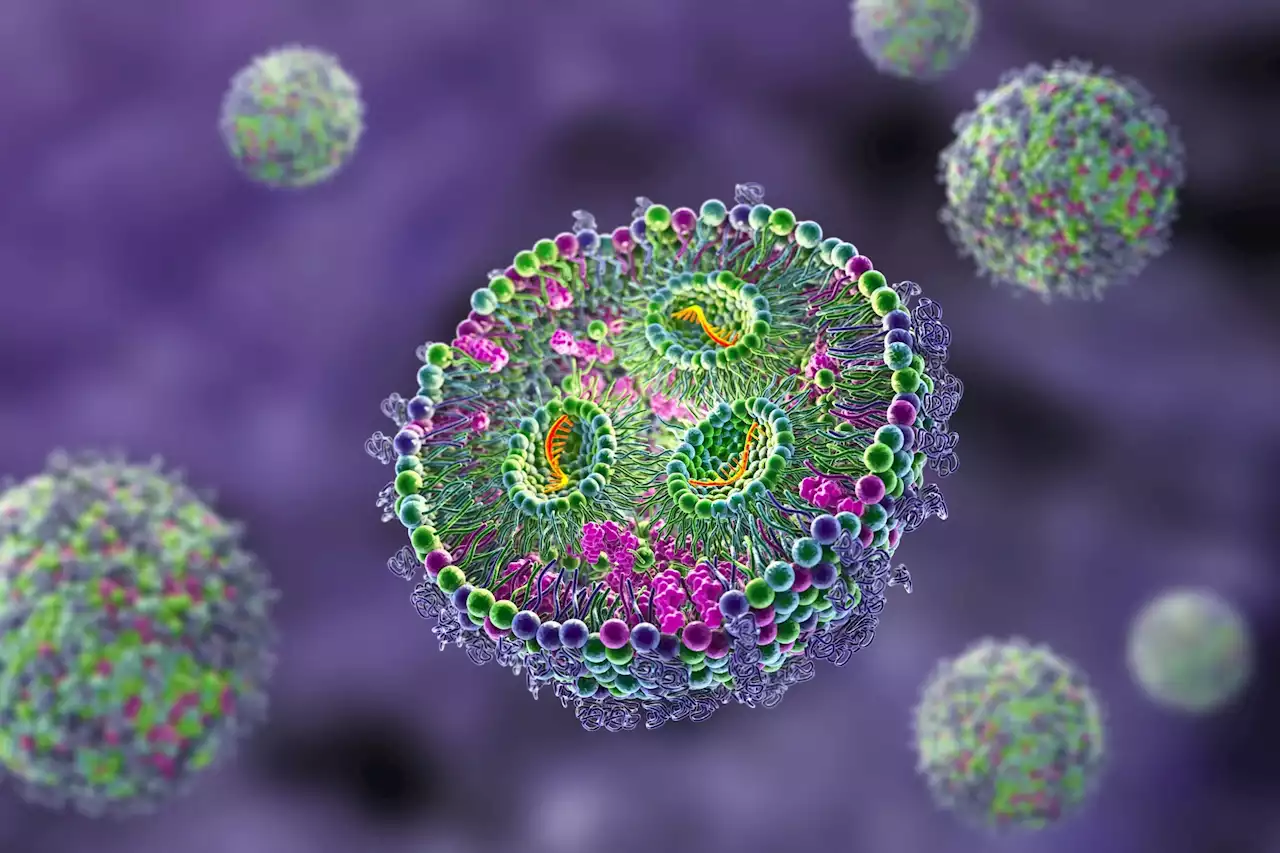Unlocking the potential of RNA lipid nanoparticles to revolutionize cancer treatment RNA lipidnanoparticles cancerimmunotherapy immunotherapy mRNA dendriticcells antigen IL23 IL36g Th1transformation oncology cancerresearch CellCellPress
By Pooja Toshniwal PahariaApr 18 2023Reviewed by Lily Ramsey, LLM In a recent review published in the journal Cell, researchers discussed advancements in ribonucleic acid -comprising lipid nanoparticle -based immunotherapies for cancer and the improvements required for next-generation vaccines.
Commentary: Delivering the next generation of cancer immunotherapies with RNA. Image Credit: Kateryna Kon / Shutterstock Further, single-stranded messenger ribonucleic acid can code for tumor vaccine neoantigens, whereas double-stranded small interfering RNA can encode knockdown checkpoint inhibitors to tune immune responses by RNA-induced activation of suppressed immune cells. Circular-type RNA can increase the duration of expression, benefiting in vivo chimeric antigen receptor generation and vaccine antigens.
Improving mRNA vaccines for next-generation immunotherapy To develop effective next-generation vaccines based on mRNA technology, increasing cancer vaccine candidates, and improving RNA-LNP potency and tolerability, are required. Further research must be conducted to improve our understanding of cancers, and antigens with a broader tumor range must be designed.
Österreich Neuesten Nachrichten, Österreich Schlagzeilen
Similar News:Sie können auch ähnliche Nachrichten wie diese lesen, die wir aus anderen Nachrichtenquellen gesammelt haben.
 BGT fans say there are 'too many' child acts and call for a 'ban'Some say there should be a minimum age limit for acts in order to audition
BGT fans say there are 'too many' child acts and call for a 'ban'Some say there should be a minimum age limit for acts in order to audition
Weiterlesen »
 The cervical lymph node contributes to peripheral inflammation related to Parkinson’s disease - Journal of NeuroinflammationBackground Peripheral inflammation is an important feature of Parkinson’s disease (PD). However, if and how CNS pathology is involved in the peripheral inflammation in PD remains to be fully investigated. Recently, the existence of meningeal lymphatics and its involvement in draining cerebral spinal fluid (CSF) to the cervical lymph node has been discovered. It is known that meningeal lymphatic dysfunction exists in idiopathic PD. The deep cervical lymph node (dCLN) substantially contributes to the drainage of the meningeal lymphatics. In addition, one of the lymphatics draining components, CSF, contains abundant α-synuclein (α-syn), a protein critically involved in PD pathogenesis and neuroinflammation. Thus, we began with exploring the possible structural and functional alterations of the dCLN in a PD mouse model (A53T mice) and investigated the role of pathological α-syn in peripheral inflammation and its potential underlying molecular mechanisms. Methods In this study, the transgenic mice (prnp-SNCA*A53T) which specifically overexpressed A53T mutant α-syn in CNS were employed as the PD animal model. Immunofluorescent and Hematoxylin and eosin staining were used to evaluate structure of dCLN. Inflammation in dCLNs as well as in bone-marrow-derived macrophages (BMDMs) was assessed quantitatively by measuring the mRNA and protein levels of typical inflammatory cytokines (including IL-1β, IL-6 and TNF-α). Intra-cisterna magna injection, flow cytometric sorting and electrochemiluminescence immunoassays were applied to investigate the lymphatic drainage of α-syn from the CNS. RNA-seq and Western blot were used to explore how pathological α-syn mediated the inflammation in PD mice. Results The results unequivocally revealed substantially enlarged dCLNs, along with slow lymphatic flow, and increased inflammation in the dCLNs of A53T mice. Oligomeric α-syn drained from CSF potently activated macrophages in the dCLN via endoplasmic reticulum (ER) stress. Notably, inhibiti
The cervical lymph node contributes to peripheral inflammation related to Parkinson’s disease - Journal of NeuroinflammationBackground Peripheral inflammation is an important feature of Parkinson’s disease (PD). However, if and how CNS pathology is involved in the peripheral inflammation in PD remains to be fully investigated. Recently, the existence of meningeal lymphatics and its involvement in draining cerebral spinal fluid (CSF) to the cervical lymph node has been discovered. It is known that meningeal lymphatic dysfunction exists in idiopathic PD. The deep cervical lymph node (dCLN) substantially contributes to the drainage of the meningeal lymphatics. In addition, one of the lymphatics draining components, CSF, contains abundant α-synuclein (α-syn), a protein critically involved in PD pathogenesis and neuroinflammation. Thus, we began with exploring the possible structural and functional alterations of the dCLN in a PD mouse model (A53T mice) and investigated the role of pathological α-syn in peripheral inflammation and its potential underlying molecular mechanisms. Methods In this study, the transgenic mice (prnp-SNCA*A53T) which specifically overexpressed A53T mutant α-syn in CNS were employed as the PD animal model. Immunofluorescent and Hematoxylin and eosin staining were used to evaluate structure of dCLN. Inflammation in dCLNs as well as in bone-marrow-derived macrophages (BMDMs) was assessed quantitatively by measuring the mRNA and protein levels of typical inflammatory cytokines (including IL-1β, IL-6 and TNF-α). Intra-cisterna magna injection, flow cytometric sorting and electrochemiluminescence immunoassays were applied to investigate the lymphatic drainage of α-syn from the CNS. RNA-seq and Western blot were used to explore how pathological α-syn mediated the inflammation in PD mice. Results The results unequivocally revealed substantially enlarged dCLNs, along with slow lymphatic flow, and increased inflammation in the dCLNs of A53T mice. Oligomeric α-syn drained from CSF potently activated macrophages in the dCLN via endoplasmic reticulum (ER) stress. Notably, inhibiti
Weiterlesen »
 MiR-3180 inhibits hepatocellular carcinoma growth and metastasis by targeting lipid synthesis and uptake - Cancer Cell InternationalPurpose Reprogrammed lipid metabolism is a hallmark of cancer that provides energy, materials, and signaling molecules for rapid cancer cell growth. Cancer cells acquire fatty acids primarily through de novo synthesis and uptake. Targeting altered lipid metabolic pathways is a promising anticancer strategy. However, their regulators have not been fully investigated, especially those targeting both synthesis and uptake. Methods Immunohistochemistry was performed on samples from patients with hepatocellular carcinoma (HCC) to establish the correlation between miR-3180, stearoyl-CoA desaturase-1 (SCD1), and CD36 expression, quantified via qRT-PCR and western blotting. The correlation was analyzed using a luciferase reporter assay. Cell proliferation, migration, and invasion were analyzed using CCK-8, wound healing, and transwell assays, respectively. Oil Red O staining and flow cytometry were used to detect lipids. Triglycerides and cholesterol levels were analyzed using a reagent test kit. CY3-labeled oleic acid transport was analyzed using an oleic acid transport assay. Tumor growth and metastasis were detected in vivo in a xenograft mouse model. Results MiR-3180 suppressed de novo fatty acid synthesis and uptake by targeting the key lipid synthesis enzyme SCD1 and key lipid transporter CD36. MiR-3180 suppressed HCC cell proliferation, migration, and invasion in an SCD1- and CD36-dependent manner in vitro. The mouse model demonstrated that miR-3180 inhibits HCC tumor growth and metastasis by inhibiting SCD1- and CD36-mediated de novo fatty acid synthesis and uptake. MiR-3180 expression was downregulated in HCC tissues and negatively correlated with SCD1 and CD36 levels. Patients with high miR-3180 levels showed better prognosis than those with low levels. Conclusions Our investigation indicates that miR-3180 is a critical regulator involved in de novo fatty acid synthesis and uptake, which inhibits HCC tumor growth and metastasis by suppressing SCD1 and CD36. Therefo
MiR-3180 inhibits hepatocellular carcinoma growth and metastasis by targeting lipid synthesis and uptake - Cancer Cell InternationalPurpose Reprogrammed lipid metabolism is a hallmark of cancer that provides energy, materials, and signaling molecules for rapid cancer cell growth. Cancer cells acquire fatty acids primarily through de novo synthesis and uptake. Targeting altered lipid metabolic pathways is a promising anticancer strategy. However, their regulators have not been fully investigated, especially those targeting both synthesis and uptake. Methods Immunohistochemistry was performed on samples from patients with hepatocellular carcinoma (HCC) to establish the correlation between miR-3180, stearoyl-CoA desaturase-1 (SCD1), and CD36 expression, quantified via qRT-PCR and western blotting. The correlation was analyzed using a luciferase reporter assay. Cell proliferation, migration, and invasion were analyzed using CCK-8, wound healing, and transwell assays, respectively. Oil Red O staining and flow cytometry were used to detect lipids. Triglycerides and cholesterol levels were analyzed using a reagent test kit. CY3-labeled oleic acid transport was analyzed using an oleic acid transport assay. Tumor growth and metastasis were detected in vivo in a xenograft mouse model. Results MiR-3180 suppressed de novo fatty acid synthesis and uptake by targeting the key lipid synthesis enzyme SCD1 and key lipid transporter CD36. MiR-3180 suppressed HCC cell proliferation, migration, and invasion in an SCD1- and CD36-dependent manner in vitro. The mouse model demonstrated that miR-3180 inhibits HCC tumor growth and metastasis by inhibiting SCD1- and CD36-mediated de novo fatty acid synthesis and uptake. MiR-3180 expression was downregulated in HCC tissues and negatively correlated with SCD1 and CD36 levels. Patients with high miR-3180 levels showed better prognosis than those with low levels. Conclusions Our investigation indicates that miR-3180 is a critical regulator involved in de novo fatty acid synthesis and uptake, which inhibits HCC tumor growth and metastasis by suppressing SCD1 and CD36. Therefo
Weiterlesen »
